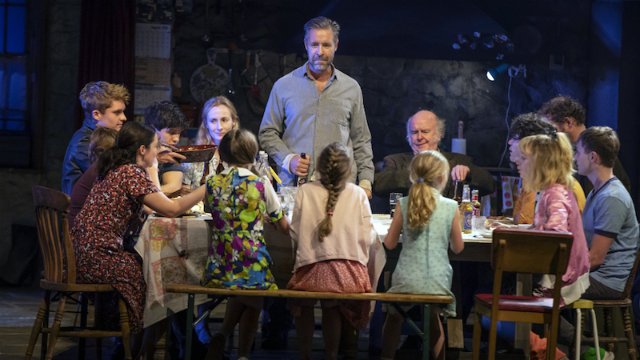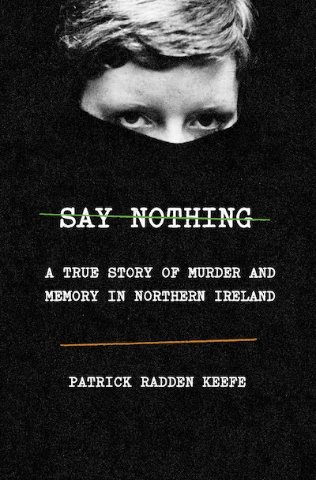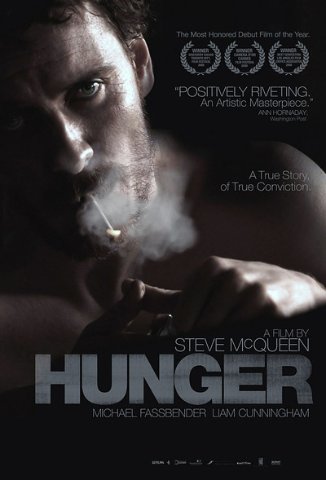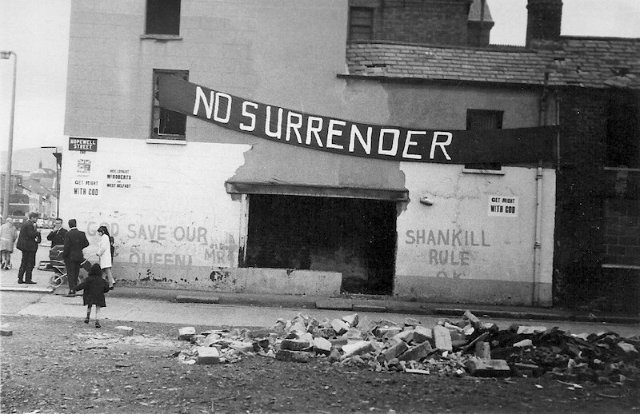The Irish Troubles
An Overview in the Arts
By: Nancy Bishop - Jul 19, 2019
The Irish are known for their devotion to language and love of talking. In his one-man show, On Beckett, multitalented artist Bill Irwin pays homage to the Irish playwright with whose words his life has been intertwined. But the Irish are also known for the political strife that has rocked their home countries for generations. We can see this in the plays of Sean O’Casey, who wrote vividly about the Easter Rising and the Irish war for independence in the 1920s. And we find it also in the poems of Nobel Prize winner Seamus Heaney, especially “Whatever You Say Say Nothing” and “Casualty.”
A particular period of Irish history has been the focus of several recent remarkable works of art: two books, one an experimental novel, and the other journalistic nonfiction, plus a much-praised Broadway drama. All of them won multiple awards. I’ll also add a 2008 film to this list of artistic works. They all commemorate the years of the Troubles, that period of history of Northern Ireland in which more than 3500 people died or were disappeared. The Troubles—years of IRA paramilitary action against the British and the Northern Ireland authorities—is usually described as running from the late 1960s to the 1998 Belfast or Good Friday agreement, a ceasefire and peace agreement between the British and Irish governments, and most of the political parties in Northern Ireland, on how Northern Ireland should be governed. It’s been an imperfect peace, most observers agree, and that peace is further threatened by the likelihood of a “hard Brexit.” The end of UK membership in the EU would mean the end of an open border between the independent Republic of Ireland and the six counties of Northern Ireland, part of the UK.
These four works of art mesmerized me during the last year. They all succeed in identifying and dramatizing critical issues for a broader audience. Although many other fights for freedom are commemorated in works of art, it seems to me that there’s more art created on the Irish fight for independence—throughout Irish history and in particular, the period known as the Troubles—than on other political periods, no matter how epic. So let me tell you about these works and encourage you to engage with them, if you have not already. And if you have, please send your thoughts in the comments section or on social media.
These two 2018 books won the George Orwell Prizes for political writing, recently announced for 2019. The play and film also won many awards.
Milkman by Anna Burns, a Northern Irish writer, also won the 2018 Man Booker Award. The story is set in an unnamed city in an unnamed country where the wrong flag or the wrong jacket or being in the wrong place can be deadly.
Say Nothing: A True Story of Murder and Memory in Northern Ireland by Patrick Radden Keefe. is a journalistic and heavily sourced and annotated history. Keefe, a New Yorker staff writer, focuses on the story of a young mother kidnapped from her 10 children and uses many interviews with IRA members involved in that case and uncounted other acts of violence.
The Ferryman by Jez Butterworth, a powerful family story set in a farmhouse in Armagh near Belfast in 1981, ran for 10 months on Broadway in 2018-19 and was awarded the Tony for Best Drama in June. The backstory of The Ferryman (written by an English writer with Northern Irish heritage) is the former IRA membership of the father of the family and the IRA hunger strikers who died in a British prison.
Steve McQueen’s 2008 debut film, Hunger, is a docudrama about those IRA hunger strikers, who demanded to be treated as political prisoners rather than criminals. When the British government was adamant in refusing that demand, the prisoners led by politician-poet Bobby Sands (Michael Fassbender) embarked on hunger strikes, with a new prisoner joining the food refusal every two weeks.
And by the way, Irish Repertory Theatre staged its O’Casey season this year, with three plays by Sean O’Casey. I was able to see and review two of them in March, the month I spent in New York.
Milkman by Anna Burns
Milkman is told in the voice of middle sister, an 18-year-old who is criticized by family for reading while walking and for taking French night classes downtown. Milkman is not a real milkman; he’s a powerful married paramilitary (aka IRA) who’s decided he wants to have an affair with middle sister and is stalking her in his white van. Her mother thinks she is having an affair with Milkman because people are talking; actually middle sister has a maybe-boyfriend but she doesn’t want her mother to know about him.
Although Milkman is definitely a threat who looms over middle sister’s life throughout the book, we know from page 1 that he’s going to die. She tells us about her relationships with her own family, including the three wee sisters, the brother-in-law she runs with around the parks & reservoirs, first brother-in-law who’s probably a sexual predator, and her other sisters, including first sister and third sister. There is one character with a sort of actual name; she calls him Somebody McSomebody.
It’s a society in which violence reigns and everyone thinks they should have something to say about everyone else’s business—especially the business of an 18-year-old who just wants to be left alone to read Ivanhoe while she walks. Gossip and social pressures try to run her life.
I called Milkman an experimental novel and it is written in a peculiar way, as you can tell. No characters are named; no locations identified. Yet danger lurks at every unnamed corner, as middle sister reads while walking. Despite the lack of names, we know the time is the 1970s, the location is Belfast; the paramilitaries are the IRA; and it’s dangerous for a Catholic to be in a Protestant neighborhood. Or for a young woman to have a maybe-boyfriend car mechanic who lives in the wrong neighborhood and has a car with the wrong flag logo.
I read Milkman in March, while I was living in New York, and participated in a book discussion at the Irish Arts Center, a few blocks west of my midtown apartment. Not surprisingly, I was the only person in the group of 20 or so who wasn’t Irish. The discussion was capably led by Rachael Gilkey, director of programming and education. She started by asking us to introduce ourselves and tell about a book that we started but didn’t finish. Only one person mentioned not finishing Milkman. Several of the attendees, Irish natives, mentioned incidents that happened to them while living in Belfast during the years of the Troubles.
Milkman is a compelling book and I found it hard to put down once I got past the first 50 or 60 pages. It took me that long to get into the rhythm of the prose. It’s 350 pages, first published in 2018 by Faber & Faber Limited; the paperback edition is published by Graywolf Press.
Say Nothing: A True Story of Murder and Memory in Northern Ireland
by Patrick Radden Keefe
Keefe’s book was recommended by several participants in the book discussion at the Irish Arts Center. It’s an excellent historical parallel to Milkman.
Keefe begins the book by describing the Treasure Room in the Burns Library at Boston College. The library holds the most comprehensive collection of literature on Irish politics and culture in the U.S., with 250,000 volumes and 16 million manuscripts. The rarest and most valuable literature is kept in the Treasure Room, climate controlled and tightly secured. One day in 2003, Keefe says, two Belfast detectives arrived at the library to take possession of a set of documents and recordings from the Treasure Room—what we will later learn is the Belfast Project, extensive interviews with IRA members and other participants in the Troubles that were not to be released until after the interviewees died. These materials were now evidence in a murder case. (Despite the promises that interview transcripts and recordings would not be released, the project managers were careless about contract language and the library was not able to resist subpoenas.)
There were thousands of murders, attempted murders and disappearances during the Troubles but this one murder is where Keefe begins his story. Jean McConville, 38 years old and the mother of 10 children, is abducted from the family dwelling in Divis Flats, a Belfast housing project. She has gone through 14 pregnancies and spent half her life pregnant or recovering from pregnancy. Her husband recently died of an illness and she was left with a small pension and no paying job. The 10 children range from 6 to 20. As she’s dragged away, she tells the older ones to take care of the others until she comes back. But she never comes back. Why was Jean McConville disappeared? Her story is wound throughout Keefe’s book.
Say Nothing is a gripping series of portraits of participants in the Troubles, from the Price sisters, Dolours and Marian, who joined the provisional IRA (the Provos or not the “Official IRA”) as teenagers. By the time she was 20, Dolours was planting car bombs in London and getting rid of informers, driving them over the border to the Republic of Ireland. The Price sisters and eight others were arrested as they were escaping from the London bombing. Tried and fund guilty, the sisters were in a British prison and demanded to be moved to a prison in Northern Ireland but the British government (in the person of Margaret Thatcher) was adamant. The sisters and other prisoners went on hunger strikes for months until they were near death. The scenes where Keefe describes prison guards forcefeeding them are horrific. Dolours was released after serving seven years of her 20-year sentence. She was married to Irish actor Stephen Rea (he stars as an IRA member in the 1992 film, The Crying Game) for 20 years; they had two sons. She died in Dublin in 2013.
Keefe draws dozens of vivid portraits of IRA members and the officials who tried to capture them and break them. One of the most prominent is Brendan Hughes, an IRA mastermind, known as the Dark. Hughes considered a brilliant military strategist for the Provos and carried out many attacks against the British Army and the Royal Ulster Constabulary. He was arrested in 1973 and famously escaped in a rolled-up mattress in the back of a dustcart. He was arrested again in 1974, imprisoned at Long Kesh in Northern Ireland, and was part of the blanket protest, when prisoners demanded to be treated as political prisoners and not be forced to wear prison garb. The “blanketmen” wrapped themselves in blankets and refused to wash or shave or let guards in to empty chamber pots (the dirty protest). Hughes led the first hunger strike in 1980 and Bobby Sands took over leadership and led the second hunger strike the following year—the strike that resulted in 10 deaths. Hughes was released from prison in 1986 and lived in Belfast; later he became very critical of Sinn Fein leadership. He died in 2008.
Gerry Adams, the best known of the participants, cultivated an image as politician, negotiator and statesman, representing the Sinn Fein, a political party associated with the IRA. Despite the fact that all the IRA members interviewed said he was an IRA leader and decision maker who ordered many murders and disappearances, he forever denied that he ever belonged to the IRA. He was a negotiator in the Good Friday peace accords.
Most IRA activists were disappointed in the Good Friday accord because it didn’t go far enough. Some of them later expressed feelings of guilt about the violent acts they committed in the hopes that the result would be a united Ireland—and that would have been worth the bloodshed. But it didn’t, so was it?
The Ferryman by Jez Butterworth, directed by Sam Mendes
This thrilling play with deep roots in Irish history and tragedy was written by Jez Butterworth, an English playwright, and directed by Sam Mendes, former artistic director of the Donmar Warehouse and director of many highly regarded films, including American Beauty and Road to Perdition. (The Irish Times said, “Although Butterworth is English, The Ferryman feels like a thoroughly Irish play … there is not a single false note in the dialogue.”)
The play is set in 1981 at harvest time in Armagh. The Carney family is getting ready for its annual big celebration of a successful harvest. There are many children and animals about and often the mood is lively and cheerful. But the backstory of the iRA and the Troubles always looms.
The Ferryman opened in October 2018 with a cast that transferred from the London production. Later in the run, many of the roles were taken over by American actors. The play requires a master director because it’s a deeply layered story with a cast of 22, which includes several children. Its background is the story of the hunger strike by Republican prisoners during the Troubles in Northern Ireland in 1981. Quinn Carney (Paddy Considine), a reformed IRA activist, and his ailing wife Mary (Genevieve O’Reilly), have a large brood of children. His sister-in-law Caitlin (Laura Donnelly), widowed because Quinn’s brother disappeared after Quinn defected from the IRA, also lives with them, with her teenage son Oisin (Rob Malone). There’s sexual and romantic tension between Quinn and Caitlin.
Several relatives of the senior generation also live in the Carney farmhouse in County Armagh, so we can appreciate the humor of Uncle Patrick (Mark Lambert), the radical political rants of militant Aunt Patricia (Dearbhla Molloy) and the occasional dreamlike stories of Aunt Maggie Far Away (Fionnula Flanagan). Tom Kettle (Justin Edwards), a simple handyman, visits with a rabbit in his pocket and reminds one of Lenny in Steinbeck’s Of Mice and Men. And yes, there’s wild life on stage: rabbits, a goose and even a baby. (Well-behaved on the night I saw the play, but I would think most directors would prefer to cast a wrapped doll-figure. However, the same infant performed through the New York run.)
There are many story lines and themes in The Ferryman as it takes place over a 24-hour period. The title is an allusion to Charon, the ferryman who takes the living to the world of the dead across the river Styx. As the play begins, the family is preparing for their annual harvest celebration, but then a visitor from the past arrives to interrupt the story and add violence and political intrigue. Act one is a long and important introduction to the various threads of the story. Later the body of Caitlin’s husband, missing for 10 years, is found by turfcutters in a bog. Seamus Carney was in the IRA and possibly a tout or informant, so he was disappeared. Quinn’s IRA background is an important element as the political story builds to an explosive ending.
The Ferryman ran on Broadway for nine months, closing July 7, 2019, and won the Tony for Best Drama in June. Running time is 3.5 hours with one intermission. The story moves quickly and the direction and acting are superb. The London production of The Ferryman won 2018 Olivier Awards for Best New Play and Best Director, plus several Evening Standard Awards and a U.K. Critics’ Circle Award for Best New Play. The Ferryman will go on a U.S. tour in 2020-21 but cities and dates have not been announced. If you have a chance to see it, I recommend brushing up on the history of the Troubles to appreciate the background of the story as well as its ominous opening and explosive ending.
If you want to visualize the horrific state of the Provo IRA prisoners in British prisons, find a DVD of this 2008 film, which was Steve McQueen’s first and much praised film. The story is set in Maze aka Long Kesh, the infamous British prison, in which 10 IRA prisoners died. You see desolate dimly lit corridors and notice that liquid is streaming out below doors. It’s urine. Within a cell, prisoners smear feces over the walls. In another scene, guards carry off Bobby Sands (Michael Fassbender) and pin him down so they can cut his hair and beard and scrub him in a bath. This is the reality of the no-wash protest by the prisoners who demand to be treated as political prisoners, rather than as criminals. Words describe these events in Keefe’s Say Nothing—and although words have power, these visuals bring home what the Provos were willing to go through for their cause.
One particularly stunning scene is a 17-minute single take of Sands and the priest at a table in an empty room, as Sands tells the priest of his plans and they discuss the morality of the hunger strike. As Sands nears death from starvation, he lies in a bath with an orderly sitting nearby. The orderly shows Sands his knuckles, tattooed with the letters UDA (Ulster Defense Association, a loyalist paramilitary group). Sands glares but is too weak to do anything.
There’s relatively little dialogue in the film and only two extended conversations. And there’s no explainers about Irish history and politics. It’s an unbelievably bleak story. Roger Ebert described it as “merciless realism.” Ironically, after the hunger strike was called off, the British government gave in to most of the prisoners’ demands although they never officially conceded on the political prisoner status.
In addition to Hunger, there are at least seven other films about this one period of Irish history: Bloody Sunday (1972), The Outsider (1980), Some Mother’s Son (1996), H3 (2001), Five Minutes of Heaven (2009), Shadow Dancer (2013) and Maze (2017.
Let’s Argue About Art
There are many other excellent works that we could discuss in thinking about the influence of art on politics. Did the 1966 film The Battle of Algiers, directed by Gillo Pontecorvo, stir up support of the FLN revolution against French rule in Algeria?
Does a play like We Are Pussy Riot (or Everything Is PR) build sympathy for the Russian activists and against Russian oppression? Probably not in Russia, but more likely in the U.S. and other countries where it’s staged.
Did books and films and speeches and music turn the tide in the still-unfinished civil rights movement of the 1960s? Yes, I believe they had an impact. And that can happen again. Let’s never stop arguing about art and its impact on politics. Because art is important.





